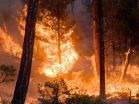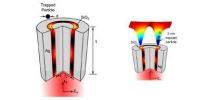(Press-News.org) Scientists using NASA satellite data and climate models have projected drier conditions likely will cause increased fire activity across the United States in coming decades. Other findings about U.S. wildfires, including their amount of carbon emissions and how the length and strength of fire seasons are expected to change under future climate conditions, were also presented Tuesday at the annual meeting of the American Geophysical Union in San Francisco.
Doug Morton of NASA's Goddard Space Flight Center in Greenbelt, Md., presented the new analysis of future U.S. fire activity. The analysis was based on current fire trends and predicted greenhouse gas emissions.
"Climate models project an increase in fire risk across the U.S. by 2050, based on a trend toward drier conditions that favor fire activity and an increase in the frequency of extreme events," Morton said.
The analysis by Morton and colleagues used climate projections, prepared for the Fifth Assessment Report of the United Nations Intergovernmental Panel on Climate Change, to examine how dryness, and therefore fire activity, is expected to change.
The researchers calculated results for low and high greenhouse gas emissions scenarios. In both cases, results suggest more fire seasons that are longer and stronger across all regions of the U.S. in the next 30-50 years. Specifically, high fire years like 2012 would likely occur two to four times per decade by mid-century, instead of once per decade under current climate conditions.
Through August of this year, the U.S. burned area topped 2.5 million hectares (6.17 million acres), according to a fire emissions database that incorporates burned area estimates produced from observations by the Moderate Resolution Imaging Spectroradiometer instruments on NASA's Aqua and Terra satellites. That is short of the record 3.2 million hectares (7.90 million acres) burned in 2011, but exceeds the area burned during 12 of the 15 years since record keeping began in 1997. This and other satellite records, along with more refined climate and emissions models, are allowing scientists to tease out new information about fire trends.
"Fire is an inherently global phenomenon, and the only practical way to track large-scale patterns and changes in fire activity is with satellites," says Louis Giglio of the University of Maryland at College Park and Goddard.
VIDEO:
The US fire season in 2012 was by some measures a record-breaking season. NASA scientist Doug Morton discusses the links between climate and wildfires and the likelihood of seeing more...
Click here for more information.
As the U.S. land area burned by fire each year has increased significantly in the past 25 years, so too have the emissions. Carbon dioxide emissions from wildfires in the western U.S. have more than doubled since the 1980s, according to Chris Williams of Clark University in Worcester, Mass.
The satellite-based view allowed Williams and his colleagues to quantify how much carbon has been released from fires in the U.S. West. The team used data on fire extent and severity derived from Landsat satellites to calculate how much biomass is burned and killed, and how quickly the associated carbon was released to the atmosphere. The team found carbon emissions from fires have grown from an average of 8 teragrams (8.8 million tons) per year from 1984 to 1995 to an average of 20 teragrams (22 million tons) per year from 1996 to 2008, increasing 2.4 times in the latter period.
"With the climate change forecast for the region, this trend likely will continue as the western U.S. gets warmer and drier on average," Williams said. "If this comes to pass, we can anticipate increased fire severity and an even greater area burned annually, causing a further rise in the release of carbon dioxide."
Researchers expect a drier and more wildfire-prone U.S. in future decades. Previous research confirmed the connection between the measure of an environment's potential evaporation, or dryness, and fire activity.
From a fire and emissions management perspective, wildfires are not the entire U.S. fire story, according to research by Hsiao-Wen Lin of the University of California at Irvine. Satellite data show agricultural and prescribed fires are a significant factor and account for 70 percent of the total number of active fires in the continental U.S. Agricultural fires have increased 30 percent in the last decade.
In contrast with wildfires, agricultural and prescribed fires are less affected by climate, especially drought, during the fire season.
"That means there is greater potential to manage fire emissions, even in a future, drier climate with more wildfires. We need to use cost-benefit analysis to assess whether reductions in agricultural fire emissions -- which would benefit public health -- would significantly impact crop yields or other ecosystem services," Lin said.
INFORMATION:
Climate models project increase in US wildfire risk
2012-12-05
ELSE PRESS RELEASES FROM THIS DATE:
Longer life expectancy, aging population necessitate new strategies for prostate cancer care
2012-12-05
The population of the United States is getting older, due not only to aging boomers but also to a four-year increase in life expectancy from 1990 to 2010. An aging population means increased diagnosis of prostate cancer. Statistically, the older the patient at time of diagnosis, the more aggressive the disease – and also the less well the patient is likely to tolerate traditional chemotherapies. In sum, we have more, aggressive prostate cancer that can't be targeted by traditional treatments.
Members of the University of Colorado Cancer Center recently published a review ...
UI researchers help find way to protect historic limestone buildings
2012-12-05
Buildings and statues constructed of limestone can be protected from pollution by applying a thin, single layer of a water-resistant coating.
That's the word from a University of Iowa researcher and her colleagues from Cardiff University in a paper published in the journal Scientific Reports, from the publishers of Nature. In the study, the researchers report a new way to minimize chemical reactions that cause buildings to deteriorate, according to Vicki Grassian, F. Wendell Miller professor in the UI departments of chemistry and chemical and biochemical engineering.
The ...
Are there racial disparities in osteoporosis screening and treatment?
2012-12-05
New Rochelle, NY, December 4, 2012—About 30 million women in the U.S. have osteoporosis, with low bone mass and deteriorating bone structure that increases their risk for fractures. Racial differences in the rates of detection and management of osteoporosis were explored in a study of African American and white women published in Journal of Women's Health, a peer-reviewed publication from Mary Ann Liebert, Inc., publishers. The article is available free on the Journal of Women's Health website at http://www.liebertpub.com/jwh.
The study, "Osteoporosis Health Care Disparities ...
Quantum thermodynamics
2012-12-05
No man is an island, entire of itself, said poet John Donne. And no atom neither. Even in the middle of intergalactic space, atoms feel the electromagnetic field---also known as the cosmic microwave background---left over by the Big Bang. The cosmos is filled with interactions that remind atoms they are not alone. Stray electric fields, say from a nearby electronic device, will also slightly adjust the internal energy levels of atoms, a process called the Stark effect. Even the universal vacuum, presumably empty of any energy or particles, can very briefly muster virtual ...
Hogging the spotlight: South Farms pig gets international attention
2012-12-05
URBANA – A detailed annotation of the genome of T.J. Tabasco, a pig from the University of Illinois South Farms, is the outcome of over 10 years of work by an international consortium. It is expected to speed progress in both biomedical and agricultural research. U of I Vice President for Research Lawrence Schook said that the College of ACES played a crucial role in getting the work started.
Funding that came through ACES allowed Schook and others to put together the Swine Genome Sequencing Consortium, an alliance of university, industry, and government laboratories ...
New optical tweezers trap specimens just a few nanometers across
2012-12-05
To grasp and move microscopic objects, such as bacteria and the components of living cells, scientists can harness the power of concentrated light to manipulate them without ever physically touching them.
Now, doctoral student Amr Saleh and Assistant Professor Jennifer Dionne, researchers at the Stanford School of Engineering, have designed an innovative light aperture that allows them to optically trap smaller objects than ever before – potentially just a few atoms in size.
The process of optical trapping – or optical tweezing, as it is often known – involves sculpting ...
Brain stimulation may buffer feelings of social pain
2012-12-05
Paolo Riva of the University of Milano-Bicocca and colleagues wanted to examine whether there might be a causal relationship between activity in the right ventrolateral prefrontal cortex (rVLPFC) – known to be involved in the regulation of physical pain and negative expressions of emotion – and experiences of social pain. Their findings are published in Psychological Science, a journal of the Association for Psychological Science.
The researchers recruited 79 university students to take part in a "mental visualization exercise." They used a constant-current regulator ...
Antiretroviral treatment for HIV reduces food insecurity, reports AIDS Journal
2012-12-05
Philadelphia, Pa. (December 4, 2012) – Can treatment with modern anti-HIV drugs help fight hunger for HIV-infected patients in Africa? Starting antiretroviral therapy for HIV reduces "food insecurity" among patients in Uganda, suggests a study published online by the journal AIDS, official journal of the International AIDS Society. AIDS is published by Lippincott Williams & Wilkins, a part ofWolters Kluwer Health..
Treatment including antiretroviral therapy (ART) may lead to a "positive feedback loop" whereby improved functioning and productivity lead to increased ability ...
'Transport infrastructure' determines spread of HIV subtypes in Africa
2012-12-05
Philadelphia, Pa. (December 4, 2012) – Road networks and geographic factors affecting "spatial accessibility" have a major impact on the spread of HIV across sub-Saharan Africa, according to a study published online by the journal AIDS, official journal of the International AIDS Society. AIDS is published by Lippincott Williams & Wilkins, a part ofWolters Kluwer Health.
Using sophisticated mapping techniques and detailed databases, Dr Andrew J. Tatem of the University of Florida and colleagues have found "coherent spatial patterns in HIV-1 subtype distributions" across ...
Breath test could possibly diagnose colorectal cancer
2012-12-05
A new study published in BJS has demonstrated for the first time that a simple breath analysis could be used for colorectal cancer screening. The study is part of the "Improving Outcomes in Gastrointestinal Cancer" supplement.
Cancer tissue has different metabolism compared to normal healthy cells and produces some substances which can be detected in the breath of these patients. Analysis of the volatile organic compounds (VOCs) linked to cancer is a new frontier in cancer screening.
Led by Donato F. Altomare, MD, of the Department of Emergency and Organ Transplantation ...



